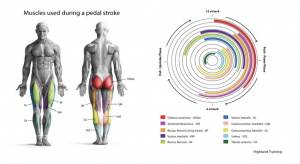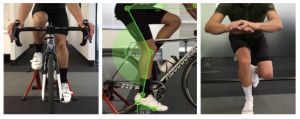If you’re one of the many cyclists switching to indoor riding, you may be experiencing soreness, or injury, that wasn’t there before.
Irrespective of whether you’re using a smart trainer, or something a little more traditional, there are many reasons why the trainer triggers soreness and injury. There are some simple things you can do to minimise discomfort and get more out of your trainer session.
Why Am I Sore on the Trainer?
The Trainer is Harder
Assuming you’re not just coasting, an indoor trainer session serves up quality and is arguably harder; there is no rest period, no traffic lights, no wheel to hold – nowhere to hide. A 60-70 minute workout may be considered the equivalent of 90 minutes outdoors.
On the trainer the resistance occurs through the entire pedal stroke, whereas on the road your ‘push phase’ is shorter. The graphic below demonstrates the large number of muscles used for what is now a longer ‘push phase’ vs the lighter load of the ‘pull phase’. In short, your body is working harder, with no respite.
As a result, the active muscles and joints work harder, and with this increased effort you will fatigue earlier, compounding the stress on both muscles and body; and thanks to the longer ‘push phase’, stress through the knee joint is particularly heightened.

Static Position
On the trainer, you maintain a static position which does help you focus on stability and maintaining power; however, it also means the muscles doing the work are less varied and ‘fewer’ and as a result, these muscles may become overworked.
Fatigue and Position
It’s well known fatigue and effort can negatively affect your body’s position on the bike (Holliday 2019) and if your trainer session is harder than a typical bunch ride, or what you’re conditioned to, you may be riding in a ‘fatigued’ position – i.e. losing form. Loss of form adds stress to the body and can be the trigger for pain and/or discomfort – particularly with the knees and lower back.
Common form issues we see on the trainer include more heel down (ankle dorsiflexion), too much knee bend (flexion), less hip flexion and more leaning forward (trunk flexion).
Gears, Power and Knees
There’s a tendency when riding indoors to use low gears to maintain power, hence less RPM for the same output. However, the lower your cadence the greater the force on your quads and knees, making it easy to overload in a way you wouldn’t on the road, potentially triggering soreness and/or injury. (Bini 2013)

The Saddle Area
Numbness, pain and saddle sores are a result of constant pressure, abnormal pressure and/or rubbing. The problem is trainer sessions are all about sustained position – there is little rocking, stopping or getting out of the saddle as you would with outdoor riding. No-one likes discomfort in the saddle area, but a sustained position can cause excess pressure in a way not experienced outdoors.
Heat and Sweat
Many of us heat up and sweat more on the trainer, even with a fan blasting in our face. Heat can cause early fatigue and dehydration, which in turn can lead to muscle pain and imbalance. Heat also causes excessive sweating and saddle wetness, a risk factor for sores and abnormal rubbing (see above) you don’t experience outdoors – and you certainly don’t want to experience indoors.
You’re on Early
On the trainer you tend to jump on and ‘hammer’ from the start – not realising you’ve skipped the lazy (warm-up) roll you’d normally have to meet your bunch ride outdoors. Sure, most trainer workouts provide a warm-up but it’s often a cursory 2-3 minutes.
Plus, the numbers displayed tend to drive us to jump in and perform earlier. Rather than the bunch warming up with a bit of a chat, you’re often ‘on’ from the start. Then, when it’s all done, it can be an abrupt stop – no 20 minute roll home or to the cafe to recover your tired legs.
Food & Drink
When indoors, we tend to ignore the eating and drinking part!
What to Do
So, the trainer is harder – but there is plenty you can do to mitigate any soreness or discomfort you may experience.

Stretch and Self-Massage
This helps to maintain your tissues & joints. Remember, the indoor trainer is often harder on your body as it uses very specific muscle groups and you may need to spend a little more time on the recovery and care of your body. It’s time to make friends with your roller!
Rest Your Buttocks and Back
Do something about that static position and move on the bike. On rest periods, or climbs, get out of the saddle. Try a pelvic tilt. Sit up. Check your shoulder position. Stretch, both your upper and lower body. Focus on a ‘long spine’. Engage your core. Where you can, find opportunities to move. If you need to, set an alarm to remind you to regularly move.
Optimise Your Bike Fit
This is always a good first step as your position indoors may be different to outdoors, or perhaps you’re riding an old bike that hasn’t had a fit for years.
Just like outdoor riding, any increase in power and/or fatigue is likely to trigger problems related to a poor bike fit and we all know the trainer is all about power and efforts!
Try a Different Set-Up
If you are having soreness or other issues, a more conservative set-up may be of benefit, providing less stress on your ‘musculoskeletal systems’.
You can achieve this in two ways:
- Bring your bars closer. Don’t want to mess with your bars? A well-positioned towel can replicate them moving up/closer.
- Move your saddle forward and up. This can be particularly useful if you tend to spend more time in the drops when riding indoor vs your normal bunch ride.
Eat and Drink Like You’re Outside
When we’re riding outdoors, we’re all aware that appropriate food and hydration are vital; but we often forget on the trainer. Proper nutrition (including hydration) not only enhances performance but is vital in supporting the body’s ability to recover – and poor recovery leads to more pain and injury!
And whilst we’re at it, don’t scrimp on sleep either. You may not be getting up at 5am but you still need solid sleep to support effort, recovery and adaptation.
Warm Up and Warm Down
If the program you’re using only has a few cursory minutes of warm up, or warm down – add in some extra time to roll, stretch, activate and lightly spin. Maybe it’s an opportunity to focus on your form, play with your cadence, or a couple of minutes to check your messages.
Maintain a High Cadence
Maintain a high cadence as you would when riding outdoors. High cadence means less work for each pedal stroke whilst maintaining the same overall power.
Strength
Even basic strength work will make you faster (Ronnestad 2010) and more resilient to injury and pain. This could be a great time to add a home routine to your training program.
Contact your Cycling Physiotherapist or your International Bike Fitting Institute expert (www.ibfi.com) for help with any of your pain and injury concerns.
Paul Visentini FACP is a Specialist Sports Physiotherapist and a Level 4 IBFI Bikefitter. He has a special interest in cycling pain and injury.
Physiosports Brighton and Pursue Health Highett are still open for management of injuries and Physio Bikefit, plus we have online solutions to assist you with setup, programs and consultations.

